If a,b,c,d,eandf are non negative real numbers such that a+b+c+d+e+f=1, then the maximum value of ab+bc+cd+de+ef is
16
1
6
14
The correct Answer is:D
Step by step video, text & image solution for If a, b, c, d, e and f are non negative real numbers such that a +b+c+d+e+f=1, then the maximum value of ab + bc + cd + de + ef is by Maths experts to help you in doubts & scoring excellent marks in Class 12 exams.
Updated on:21/07/2023Topper's Solved these Questions
- APPLICATION OF DERIVATIVEBook:FIITJEEChapter:APPLICATION OF DERIVATIVEExercise:Assignment Objective (level-2)
Explore 20 Videos
- APPLICATION OF DERIVATIVEBook:FIITJEEChapter:APPLICATION OF DERIVATIVEExercise:Comprehension
Explore 8 Videos
- APPLICATION OF DERIVATIVEBook:FIITJEEChapter:APPLICATION OF DERIVATIVEExercise:Assignment subjective (level -2)
Explore 15 Videos
- AREABook:FIITJEEChapter:AREAExercise:Numerical Based
Explore 3 Videos
Similar Questions
If the equation x5−10a3x2+b4x+c5=0 has three equal roots, then
View Solutionf:R→R,f(x) is a differentiable function such that all its successive derivatives exist. f'(x) can be zero at discrete points only and f(x)f''(x)≤0∀x∈R
If f(a)=0, then which of the following is correct
View SolutionLet f:[1,2]→[1,4]andg:[1,2]→[2,7] be two continuous bijective functions such that f(1)=4andg(2)=7. Number ofsolution of the equation f(x)=g(x) in (1,2) is equal to
View SolutionLet f(x) = minimum (tan x, cot x, 1/√3) ∀×∈[0,π/2]. Then area of bounded by y = f(x) and the x-axis is in (43)+πk√3, then the value of k is ______
View SolutionIf a,b,c,d,e and f are non negative real numbers such that a+b+c+d+e+f=1, then the maximum value of ab+bc+cd+de+ef is
View Solutionbc + cd + de + ef + fa. If a + b+ c+de f 12 then the maximum value of ab (a, b, c, d, e, fare non negative real numbers) ) 36 (B) 24 (C) 30 (D) none of these
View SolutionIn ΔABC and ΔDEF, AB= DE, AB || DE, BC= EF and BC|E|F. Vertices A, B and C are joined to vertices D, E and F respectively. Show that
Quadrilateral ABED is a parallelogram

View SolutionIn ΔABC and ΔDEF, AB= DE, AB || DE, BC= EF and BC|E|F. Vertices A, B and C are joined to vertices D, E and F respectively. Show that
Quadrilateral BEFC is a parallelogram
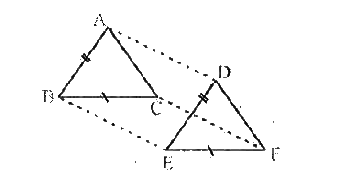
View SolutionIn ΔABC and ΔDEF, AB= DE, AB || DE, BC= EF and BC|E|F. Vertices A, B and C are joined to vertices D, E and F respectively. Show that
AD|C|F and AD = CF
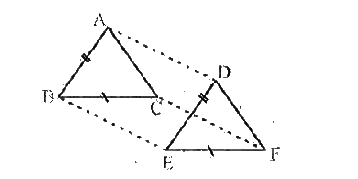
View SolutionIn ΔABC and ΔDEF, AB= DE, AB || DE, BC= EF and BC|E|F. Vertices A, B and C are joined to vertices D, E and F respectively. Show that
quadrilateral ACFD is a parallelogram
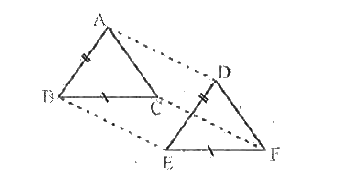
View SolutionIn ΔABC and ΔDEF, AB= DE, AB || DE, BC= EF and BC|E|F. Vertices A, B and C are joined to vertices D, E and F respectively. Show that
AC= DF
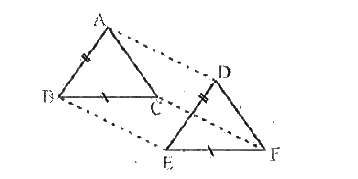
View SolutionIn ΔABC and ΔDEF, AB= DE, AB || DE, BC= EF and BC|E|F. Vertices A, B and C are joined to vertices D, E and F respectively. Show that
ΔABC≅ΔDEF.
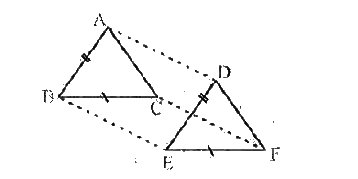
View Solution△ ABC ಮತ್ತು △ DEF ಗಳಲ್ಲಿ AB =DE, AB∣∣DE, BC = EF ಮತ್ತು BC∣∣ EF ಆಗಿದೆ. A, B ಮತ್ತು C ಶೃಂಗಗಳನ್ನು ಕ್ರಮವಾಗಿ D,E ಮತ್ತು Fಶೃಂಗಗಳಿಗೆ ಸೇರಿಸಿದೆ (ಚಿತ್ರ ಗಮನಿಸಿ). ಚತುರ್ಭುಜ ABED ಒಂದು ಸಮಾಂತರ ಚತುರ್ಭುಜ.
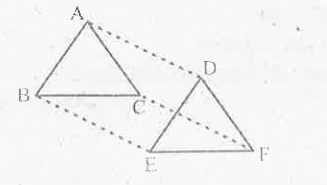 .
.
View SolutionDelta ABC And Delta DEF In AB//DE,AB=DE, BC=EF And BC //EF . ABED is a parallelogram whose vertices A, B and C are connected to D, E and F respectively.
View SolutionIn ΔABC and ΔDEF AB = DE, BC = EF and BC // EF. The vertices A, B and C are connected to D, E and F respectively AC = DF
View SolutionIn ΔABC and ΔDEF AB = DE, BC = EF and BC // EF. Show that the vertices A, B and C are ,ABC≅ΔDEF which are connected to D, E and F respectively.
View Solution
